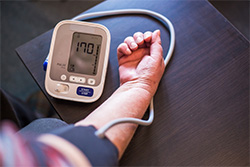 How to Buy the Best Blood Pressure Monitor for YouWATCH SEGMENT ON KFOR-TV  High blood pressure Ė known as the silent killer Ė has no obvious symptoms, yet as many as half of Americans have the condition, according to the Centers for Disease Control and Prevention. But just 24 percent of those people have the condition under control. Hypertension can increase your risk of heart attack, stroke, kidney disease, and a number of other serious health problems. If you have elevated or stage 1 high blood pressure (130/80 or higher) or you need to get a home blood pressure monitor. Home monitoring can help you keep tabs on your blood pressure in a comfortable setting. Plus, if youíre taking medication it will make certain itís working, and alert you to a health problem if it arises.
Types of Monitors With an automatic arm monitor, you simply wrap the cuff around your bicep and with the push of one button the cuff inflates and deflates automatically giving you your blood pressure reading on the display window in a matter of seconds. Wrist monitors work similarly, except they attach to the wrist. Wrist monitors are also smaller in weight and size, which makes them more portable, and a bit more comfortable to use than the arm monitors, but they tend to be a little less accurate. To help you choose the best monitor for you, here are several things to check into: Make sure it fits: Be sure the cuff fits the circumference of your upper arm. Using a cuff thatís the wrong size can result in an inaccurate reading. Most arm models have two sizes or an adjustable cuff that fits most people. Wrist models also fit most people. Choose one thatís easy to use: Be sure the display on the monitor is easy to read, and that the buttons are large. The directions for applying the cuff and operating the monitor should be clear. Consider what extra features you want: Many automatic monitors come with additional features such as irregular heartbeat detection that checks for arrhythmias and other abnormalities; a risk category indicator that tells you whether your blood pressure is in the high range; a data-averaging function that allows you to take multiple readings and get an overall average; multiple user memory that allows two or more users to save their readings; and downloadable memory that lets you transmit your data to your computer or smartphone.
Where to Buy In most cases, original Medicare will not cover a home blood pressure monitor, but if you have a Medicare Advantage plan or a private health insurance policy itís worth checking into, because some plans may provide coverage. One of the best automatic arm monitors as recommended by Consumer Reports is the Omron Platinum BP5450 ($75, OmronHealthcare.com). And the top wrist monitor is the Omron 7 Series BP6350 ($80). After you buy a monitor, itís a good idea to take it to your doctorís office so they can check its accuracy and make sure youíre using it properly You can also get more detailed information on how to accurately measure your blood pressure at home at Heart.org/HBP Ė click on ďLearn How to Monitor Your Blood Pressure at Home.Ē |




